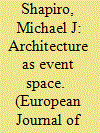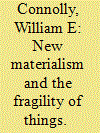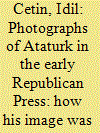|
|
|
Sort Order |
|
|
|
Items / Page
|
|
|
|
|
|
|
| Srl | Item |
| 1 |
ID:
169165


|
|
|
|
|
| Summary/Abstract |
Central to the conception of this article is the architectural theorist Bernard Tschumi's dictum, ‘There is no architecture without action, no architecture without events, no architecture without program … no architecture without violence.’ Shaped as well by Eyal Weizman's conception of ‘forensic architecture’, the focus of the investigation is on Israel's architecture of security and on the corresponding Palestinian architecture of resistance. Emphasising an encounter of cartographies that reveals the way Palestinians make life livable in response to the architectural violence they face, the analysis continues with reference to Yari Sharif's analysis of architectures of resistance and with a reading of a feature film, Hany Abu-Assad's Omar (2013) in which the Separation Wall between Israel and Palestine is one of the film's primary agent/protagonists. The article surveys popular culture texts, focused on crime and espionage to analyse a range of security practices and breaches that amplify the analysis with attention to security issues in individual households, multiple-person dwelling arrangements, architectural locations throughout cities, and buildings housing governmental security agencies. That trajectory of architectural sites lends a micropolitical analysis to the macropolitical level of governmental policy and modes of resistance to it.
|
|
|
|
|
|
|
|
|
|
|
|
|
|
|
|
| 2 |
ID:
142626


|
|
|
|
|
| Summary/Abstract |
This article conducts a comparative analysis of a catastrophic flood that hit the Kulob region of southern Tajikistan in 2010, and the government of Tajikistan's campaign to gather money to build the Roghun dam and hydropower station. It advances the notion of ‘everyday disasters’ in order to explain the imprecise boundaries between major catastrophic events and more mundane dimensions of the everyday as experienced by residents of Kulob. The article seeks to shed light, firstly, on the processes that underpin both Kulob residents’ experiences of stagnation and the normalization of non-development, and, secondly, on the ways in which Kulob residents joke and ‘do’ cunning/cheating whilst dealing with disastrous events in order to cultivate an everydayness that is worth living.
|
|
|
|
|
|
|
|
|
|
|
|
|
|
|
|
| 3 |
ID:
123579


|
|
|
|
|
| Publication |
2013.
|
| Summary/Abstract |
The 'new materialism' is the most common name given to a series of movements in several fields that criticise anthropocentrism, rethink subjectivity by playing up the role of inhuman forces within the human, emphasize the self-organizing powers of several nonhuman processes, explore dissonant relations between those processes and cultural practice, rethink the sources of ethics, and commend the need to fold a planetary dimension more actively and regularly into studies of global, interstate and state politics. After reviewing several key tenets of this diverse movement in philosophy, biology and the human sciences, we focus on how it casts light on the dissonant relations between the drives of neoliberal capitalism and boomerang effects from nonhuman forces. Exploration of such relations both dramatises the fragility of things today and helps to explain why many constituencies refuse to acknowledge and address it. After presenting a few capital-force-field conjunctions that illustrate the fragility of things, this article briefly explores some intercoded counter-strategies to address the contemporary predicament.
|
|
|
|
|
|
|
|
|
|
|
|
|
|
|
|
| 4 |
ID:
166765


|
|
|
|
|
| Summary/Abstract |
Since its invention, photography has been seen as representing reality as it was, as a result of which an evidential quality has been attributed to it. This quality comes more to the fore in certain contexts, one of them being press photography. Photographs in a newspaper are meant to testify to the event described in the news. This article looks at the photographs of Mustafa Kemal Ataturk, the founder of the Turkish Republic, which were circulated in the early Republican Press. Many photographs of Ataturk which were published in the periodicals at that time did not testify to the actualization of an event and henceforth did not provide any evidence for the events. They nevertheless have an evidential quality, which they acquire not from what they show, but from what they signify.
|
|
|
|
|
|
|
|
|
|
|
|
|
|
|
|
|
|
|
|
|